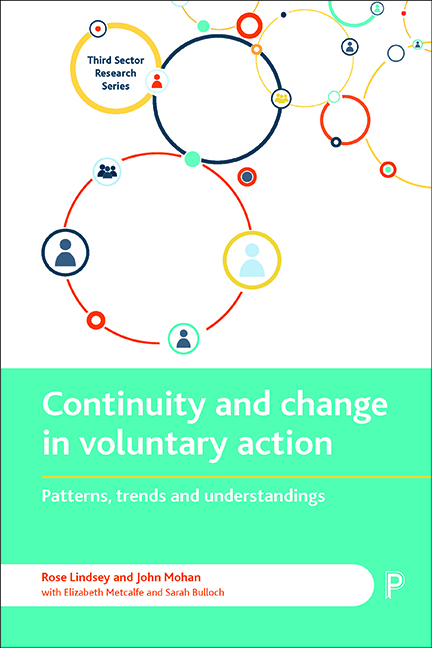Book contents
- Frontmatter
- Contents
- List of figures and tables
- Foreword
- Acknowledgements
- Notes on authors
- Acronyms
- one Introduction
- two The changing policy environment for voluntary action from 1979
- three Data: sources and definitions
- four Trends in volunteering and trends in the voluntary sector
- five Content and context of volunteering
- six Why people volunteer: contextualising motivation
- seven Volunteering trajectories: individual patterns of volunteering over the lifecourse
- eight Attitudes to voluntary action
- nine Conclusions
- Appendix: Anonymised details of writers
- References
- Index
Foreword
Published online by Cambridge University Press: 13 April 2022
- Frontmatter
- Contents
- List of figures and tables
- Foreword
- Acknowledgements
- Notes on authors
- Acronyms
- one Introduction
- two The changing policy environment for voluntary action from 1979
- three Data: sources and definitions
- four Trends in volunteering and trends in the voluntary sector
- five Content and context of volunteering
- six Why people volunteer: contextualising motivation
- seven Volunteering trajectories: individual patterns of volunteering over the lifecourse
- eight Attitudes to voluntary action
- nine Conclusions
- Appendix: Anonymised details of writers
- References
- Index
Summary
This is the third volume to appear in the Third Sector Research Series. Previous contributions have focused primarily on the organisational base of the sector, and this will continue in planned books on the third sector in the devolved administrations of the UK, on the geography of the sector, and on attempts to build the infrastructure of the third sector to support organisational development.
In this book the emphasis shifts to action by individuals – in many ways a defining feature of the third/voluntary sector. The extent, distribution, measurement and meanings of volunteering formed an important strand in the research of the Third Sector Research Centre (TSRC). These have also been issues of direct public concern, with great weight being attached, in particular during the UK Coalition government (2010–15), to trends in voluntary activity. Understanding volunteering is thus of central political, and academic, interest. The innovative approach embodied in this book mean that it will make a significant addition to the current body of literature on volunteering.
First, the authors have drawn on more than three decades of survey data. Despite variation in the approaches taken by these surveys, they demonstrate the long-term stability of volunteering rates. Second, recognising that there is considerable disagreement about how to define and measure voluntary action, the authors also examine contemporaneous qualitative evidence from individuals about the nature and meaning of their voluntary activities. This has been achieved through a long-term collaboration with the Mass Observation Archive, using qualitative material submitted by individuals in which they describe the nature and meaning of their voluntary activities, and discuss their attitudes to volunteering.
The result of this research is a rich mixed-methods study which offers important lessons, both positive and negative, about the nature of voluntary action. The quantitative research reveals that those seeking to raise levels of voluntary action should be more cautious in their claims regarding the extent to which it is possible to do so. The overall message here is that there has been stability in voluntary engagement, albeit with short-term fluctuations largely related to economic circumstances. The good news is that volunteering rates have not declined; the bad news is that despite generally rising prosperity, and increased levels of participation in higher education, neither have they risen.
- Type
- Chapter
- Information
- Continuity and Change in Voluntary ActionPatterns, Trends and Understandings, pp. v - viPublisher: Bristol University PressPrint publication year: 2018

